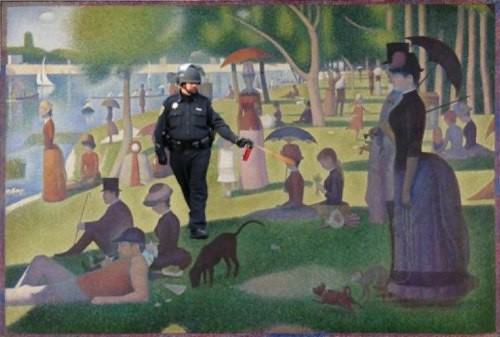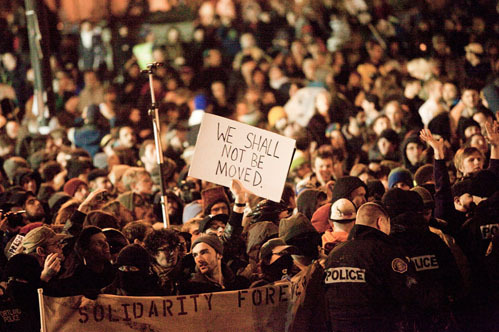Author Archives: Mark
A Great Explanation of SOPA
Somebody constructed this video explaining SOPA. It’s a great teaching tool for something few understand. It is also crafted in such a way that if SOPA were passed the distribution company of this movie would be able to pull down my site, and remove referenced to my entire site from all search engines. I would, and do, have a legal basis for using it because it is fair use and is definitely parody by being paradoxical (using copyrighted content as a social meme to explain how the law is wrong). However, if SOPA is passed, my site would be taken down first, then I would have to hire a lawyer and go to court with a major Hollywood studio to make that point and get my site re-established. And I didn’t even make or post this video, I just have a link to it.
SOPA is a shoot-first, ask questions later law, which is why it would cripple the Internet.
Jay Mathews, Washington Post & Teachers and Lesson Plans
In today’s Washington Post, Jay Mathews writes:
New teacher decries lesson plan gap
Maybe Bruce Friedrich raised the lesson plan issue because he was so out of sync with the recent college graduates who were the other Teach for America instructors at his Baltimore high school. He was 40. He had switched to education after first running a homeless shelter and then working for animal rights.
He thought it was odd that despite the forward-looking reputation of the Baltimore district and Teach for America, beginning teachers still had to construct their lessons from scratch, as teachers have done for centuries. They were shown samples of the state tests their students would have to take. They were told where they might find good material. But as rookies, they had little idea which of a million possible options would work.
“There were no exemplary lesson plans, no recommended class activities, nothing,” he said.
Friedrich asked about this at every faculty meeting and every conference with his Teach for America adviser. He learned that many teachers, and the organizations that represent them, don’t want ready-made lesson plans. They feel it limits their creativity and turns them into robots doing whatever their department head or the district curriculum chief wants.
Friedrich began teaching in 2009 and had a splendid two years in Teach for America. His second year he was named the school’s outstanding teacher. But he still doesn’t understand why the district didn’t try to save him and other novices from many beginner’s mistakes by offering the best lesson plan possible for each subject.
Jeff Wetzler, Teach for America’s executive vice president of teacher preparation, support and development, showed me a 2010 survey of the organization’s beginning teachers in 31 states and the District. Forty-one percent said their districts provided them with low-quality instructional tools like lesson plans, or none at all. Twenty-seven percent were provided with tools they were required to use, and 7 percent got tools that they used because their colleagues used them. Only 15 percent said they were provided tools that they used freely because they were of such high quality. Teach For America instructors in the District and Prince George’s County do their own lesson plans.
Wetzler explained that Teach for America corps members share lesson plans on a special online portal, and often rank those they consider best. But many still feel as Friedrich did: How are they supposed to know what works when they have so little experience? Couldn’t the experts get together and give us the best possible guide?
–The article continues …
Here’s the comment I left:
Jay,
You’ve missed the mark. Teaching has to start with the students sitting in the class – their abilities, challenges and attitude. It doesn’t start with a lesson plan. Great lesson plans are drafted by skilled teachers to best broach the subject to their specific students in their specific class on that specific day.
It would be like you asking for journalistic story model on which you can base all your writing. They might help, a little, but as you got to be a better journalist, they would be almost worthless. That’s why you can find story models in journalism 101, but not in an online sharing site for the top reporters at the Washington Post.
Teach For America has a lot of good-hearted amateurs, trying to do the work of professionals. Unfortunately for us professional educators, journalists like you put too much credibility to the gripes of some TFA newcomer months into their new career. I’m also a career changer – 25 years in journalism at the highest levels and 7 years in teaching. I might have said the same thing about lesson plans my first year or two, of course, I didn’t know anything about teaching then.

Revolution, Che Guevara and Occupy Wall Street/Everything

Che Guevara wrote about popular uprising and one of the main tenants is, one can’t win a battle against a major organized military force. One can create a climate of fear within the establishment which prompts violent and unwarranted backlash, and such force when seen by the general population is galvanizing for the great sea of populace which makes up the support and force of the rebel vanguard.
I guess nobody’s read anything about popular uprising lately.

Protests on Campus Turn Violent – We Need To Start Thinking
So the media lampooned the Tea Party, and nothing was done about them. Jokers in hats. Nobody in the group really stood for anything. Ignore them and they’ll go away, peter out, become irrelevant after their 15 minutes of attention.
Then they came back in the mid-terms and kicked everybody’s ass, especially the Republicans who thought they had cooped the group.
Fast forward to Occupy Wall Street and Occupy Everything. Nobody’s taking that chance. They are forcibly removing them, just before the freezing cold can set in and Winter gets the job done without any show of force.
And at college campuses, the type of decisions that lead to the shootings at Kent State (May 4, 1970) are being made, again.
Here’s a letter by a University of California, Davis professor about the recent non-violent protests there and the violence that was used to break them up:
The youtube links tell the story.
—————————
Open Letter to Chancellor Linda P.B. Katehi
18 November 2011
Linda P.B. Katehi,
I am a junior faculty member at UC Davis. I am an Assistant Professor in the Department of English, and I teach in the Program in Critical Theory and in Science & Technology Studies. I have a strong record of research, teaching, and service. I am currently a Board Member of the Davis Faculty Association. I have also taken an active role in supporting the student movement to defend public education on our campus and throughout the UC system. In a word: I am the sort of young faculty member, like many of my colleagues, this campus needs. I am an asset to the University of California at Davis.
You are not.
I write to you and to my colleagues for three reasons:
1) to express my outrage at the police brutality which occurred against students engaged in peaceful protest on the UC Davis campus today
2) to hold you accountable for this police brutality
3) to demand your immediate resignation
Today you ordered police onto our campus to clear student protesters from the quad. These were protesters who participated in a rally speaking out against tuition increases and police brutality on UC campuses on Tuesday—a rally that I organized, and which was endorsed by the Davis Faculty Association. These students attended that rally in response to a call for solidarity from students and faculty who were bludgeoned with batons,hospitalized, and arrested at UC Berkeley last week. In the highest tradition of non-violent civil disobedience, those protesters had linked arms and held their ground in defense of tents they set up beside Sproul Hall. In a gesture of solidarity with those students and faculty, and in solidarity with the national Occupy movement, students at UC Davis set up tents on the main quad. When you ordered police outfitted with riot helmets, brandishing batons and teargas guns to remove their tents today, those students sat down on the ground in a circle and linked arms to protect them.
Without any provocation whatsoever, other than the bodies of these students sitting where they were on the ground, with their arms linked, police pepper-sprayed students. Students remained on the ground, now writhing in pain, with their arms linked.
What happened next?
Police used batons to try to push the students apart. Those they could separate, they arrested, kneeling on their bodies and pushing their heads into the ground. Those they could not separate, they pepper-sprayed directly in the face, holding these students as they did so. When students covered their eyes with their clothing, police forced open their mouths and pepper-sprayed down their throats. Several of these students were hospitalized. Others are seriously injured. One of them, forty-five minutes after being pepper-sprayed down his throat, was still coughing up blood.
This is what happened. You are responsible for it.
You are responsible for it because this is what happens when UC Chancellors order police onto our campuses to disperse peaceful protesters through the use of force: students get hurt. Faculty get hurt. One of the most inspiring things (inspiring for those of us who care about students who assert their rights to free speech and peaceful assembly) about the demonstration in Berkeley on November 9 is that UC Berkeley faculty stood together with students, their arms linked together. Associate Professor of English Celeste Langan was grabbed by her hair, thrown on the ground, and arrested. Associate Professor Geoffrey O’Brien was injured by baton blows. Professor Robert Hass, former Poet Laureate of the United States, National Book Award and Pulitzer Prize winner, was also struck with a baton. These faculty stood together with students in solidarity, and they too were beaten and arrested by the police. In writing this letter, I stand together with those faculty and with the students they supported.
One week after this happened at UC Berkeley, you ordered police to clear tents from the quad at UC Davis. When students responded in the same way—linking arms and holding their ground—police also responded in the same way: with violent force. The fact is: the administration of UC campuses systematically uses police brutality to terrorize students and faculty, to crush political dissent on our campuses, and to suppress free speech and peaceful assembly. Many people know this. Many more people are learning it very quickly.
You are responsible for the police violence directed against students on the UC Davis quad on November 18, 2011. As I said, I am writing to hold you responsible and to demand your immediate resignation on these grounds.
On Wednesday November 16, you issued a letter by email to the campus community. In this letter, you discussed a hate crime which occurred at UC Davis on Sunday November 13. In this letter, you express concern about the safety of our students. You write, “it is particularly disturbing that such an act of intolerance should occur at a time when the campus community is working to create a safe and inviting space for all our students.” You write, “while these are turbulent economic times, as a campus community, we must all be committed to a safe, welcoming environment that advances our efforts to diversity and excellence at UC Davis.”
I will leave it to my colleagues and every reader of this letter to decide what poses a greater threat to “a safe and inviting space for all our students” or “a safe, welcoming environment” at UC Davis: 1) Setting up tents on the quad in solidarity with faculty and students brutalized by police at UC Berkeley? or 2) Sending in riot police to disperse students with batons, pepper-spray, and tear-gas guns, while those students sit peacefully on the ground with their arms linked? Is this what you have in mind when you refer to creating “a safe and inviting space?” Is this what you have in mind when you express commitment to “a safe, welcoming environment?”
I am writing to tell you in no uncertain terms that there must be space for protest on our campus. There must be space for political dissent on our campus. There must be space for civil disobedience on our campus. There must be space for students to assert their right to decide on the form of their protest, their dissent, and their civil disobedience—including the simple act of setting up tents in solidarity with other students who have done so. There must be space for protest and dissent, especially, when the object of protest and dissent is police brutality itself. You may not order police to forcefully disperse student protesters peacefully protesting police brutality. You may not do so. It is not an option available to you as the Chancellor of a UC campus. That is why I am calling for your immediate resignation.
Your words express concern for the safety of our students. Your actions express no concern whatsoever for the safety of our students. I deduce from this discrepancy that you are not, in fact, concerned about the safety of our students. Your actions directly threaten the safety of our students. And I want you to know that this is clear. It is clear to anyone who reads your campus emails concerning our “Principles of Community” and who also takes the time to inform themselves about your actions. You should bear in mind that when you send emails to the UC Davis community, you address a body of faculty and students who are well trained to see through rhetoric that evinces care for students while implicitly threatening them. I see through your rhetoric very clearly. You also write to a campus community that knows how to speak truth to power. That is what I am doing.
I call for your resignation because you are unfit to do your job. You are unfit to ensure the safety of students at UC Davis. In fact: you are the primary threat to the safety of students at UC Davis. As such, I call upon you to resign immediately.
Sincerely,
Nathan Brown
Assistant Professor
Department of English
Program in Critical Theory
University of California at Davis
Teacher Research and the Need for Experimentation to Drive Policy in Education
One of the things I do is work with the Education Study Group, an organization that supports teachers doing cheap and fast experimentation and data gathering on what works and doesn’t in their classroom and education as a whole.
This video explains the rational, from a Fortune 500 perspective:
Data should not be about Teacher Evaluation and Accountability, nor should it be another lever where the teaching relationship between teacher and student is managed from four levels above the classroom.


